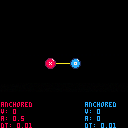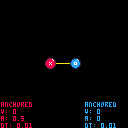The Question
Hello everyone,
I am ludicrously close to finishing the engine for my game, but some physics equations have me stuck. Here is what I'm trying to achieve:
- The players are effectively nodes that can switch between being pendulum bobs and fulcrums. One can be anchored to serve as a fulcrum while the other swings. If both are anchored, neither moves. If both try to un-anchor themselves, they fall.
- In order to let the players navigate the playfield, I want the swing of a pendulum bob to increase bit by bit. (This will let players climb the playfield by swinging upward instead of just descending.)
- Once a bob makes a full loop around the fulcrum, I want it to continue in a circle at a more-or-less consistent speed.
With the help of this math writeup, I managed to assemble a simplified set of physics variables and equations that do an okay job of simulating momentum and creating a non-degrading swing (i.e., the swing distance never shrinks due to friction). But I haven't figured out how to make the desired increase in swing distance happen. I'm sure it's a single value or sign that I haven't identified.
I suspect I need to do something to increment the value of p.a in the function move_player(p), but I am not sure how to approach it -- adding a value, multiplying by a value, etc.
Could someone better at physics/math please offer suggestions?
Thank you for any and all pointers!
The annotated code is below. It's 200 lines in total, but the relevant parts are the first ~90.


The Code

Try this: don't change dt, and instead do something like:
p.v+=(k*cos(p.a)+0.01*sgn(p.v))*p.dt |
This adds a small angular acceleration in the direction of the current velocity, and should increase the angle of swing over time.

This works beautifully! I'd never heard of sgn() before, either, but I can see it being quite useful.
All I need to do now is figure out how to speed up the swing from here.
Thank you, @luchak. You've helped me solve the last major obstacle in my game. Now for all the stuff I actually know how to do!

I actually did end up keeping the dt updates, because they made for a more pleasing swing speed. With a simple acceleration cap included, everything works nicely.
Thanks again, Luchak!


[Please log in to post a comment]





